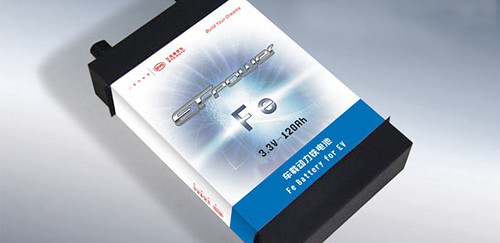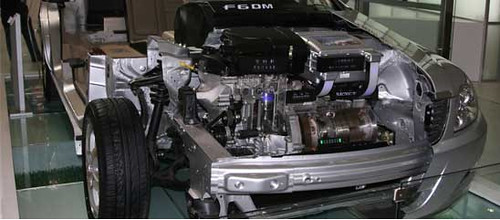
I try not to exhibit any political bias on this site because, hey, republican, democrat, libertarian, independent, everyone likes cars. And both political frontrunners this year made strong appeals for renewable, clean energy as well as electric vehicles.
McCain stressed energy independence as a way of improving international relations, because “we need to stop buying oil from countries that don’t like us very much” (he used this argument frequently). He also threw out a proposal for a $300 million dollar government prize for whoever develops an automobile battery that far surpasses current battery technology. McCain proposed to cut ethanol subsidies, which , in my opinion, is a dead horse, and offer a $5,000 tax credit to zero-emission car buyers. Obama proposed a $7000 credit for advanced-technology vehicles, plug-ins included.
Barack Obama also shed some light on his electric automobile intentions as he cut down McCain’s battery race:
After all those years in Washington, John McCain still doesn’t get it. I commend him for his desire to accelerate the search for a battery that can power the cars of the future. I’ve been talking about this myself for the last few years. But I don’t think a $300 million prize is enough. When John F. Kennedy decided that we were going to put a man on the moon, he didn’t put a bounty out for some rocket scientist to win – he put the full resources of the United States government behind the project and called on the ingenuity and innovation of the American people. – Barack Obama, Las Vegas, June 24th, 2008.
It was a pretty close presidential race in terms of being EV friendly. But as the McCain campaign went on, things went downhill. He picked Sarah Palin, who still doesn’t believe that global warming is man made. Odd, because she vowed to solve global warming somehow, without discerning the cause. Just look at Joe Biden, a longtime champion of clean tech and climate change legislation, and compare him to her. Her slogan was “drill baby drill” while Biden wants to eliminate oil company subsidies and raise gas mileage mandates:
Take away the subsidy, which I’ve introduced legislation to do. It’s about $6 billion, $2.7 billion directly, to the oil companies, number one. Number two, investigate as the president of the US. Use the Justice Department and go in and investigate this whole issue of price gouging. Number three, though, we have to do what we all have said here, but first and foremost, significantly raise the mileage automobiles get and mandate it. – Joe Biden
Source: 2007 Dem. debate at Saint Anselm College Jun 3, 2007
Obama was not very well received when, in May, he enlightened the Detroit Auto crowd to the fact that, unless they change their ways and provide more fuel-efficient cars, they will not be able to compete with the rest of the world. Unfortunately, it may be too late for GM, as it is spiraling towards bankruptcy unless they receive a government handout. And GM doesn’t seem to want to change its ways. Obama is already stressing the importance of passing a bill that will infuse $25 billion into the big 3 automakers with stipulations that force them to invest in alternative vehicles and PHEV’s. Bailing out the big 3 could be helpful to the electric car market, as Chrysler and GM are currently developing electric cars in the Volt and ENVI programs. Saving US automakers and forcing the PHEV issue would be imperative to his plan to have 1 million PHEV on the road by 2015.
A TIME article from October 22, 2008 by Joe Klein really clarifies Obama’s intentions to build a new economy based around renewable energy development:
From Time:
[Obama] has a clearer handle on the big picture, on how various policy components fit together, and a strong sense of what his top priority would be. He wants to launch an “Apollo project” to build a new alternative-energy economy. His rationale for doing so includes some hard truths about the current economic mess: “The engine of economic growth for the past 20 years is not going to be there for the next 20. That was consumer spending. Basically, we turbocharged this economy based on cheap credit.” But the days of easy credit are over, Obama said, “because there is too much deleveraging taking place, too much debt.” A new economic turbocharger is going to have to be found, and “there is no better potential driver that pervades all aspects of our economy than a new energy economy … That’s going to be my No. 1 priority when I get into office.“
Also, take into account that Obama was endorsed by Al Gore, while McCain was endorsed by George Bush and Dick Cheney. During a presidential campaign, candidates say a lot of things to appeal to a moderate public. You have to look at who endorses them and what their party stands for to get a better idea of what the candidate will actually do, once in office. The Democratic party has always been the greener party and the Obama victory is a step in the right direction for electric auto technology.
Here are some useful sites to get an idea of where Obama stands on green technology:
Clean Tech and Green Business for Obama
Obama Homepage
Popular Mechanics:McCain, Obama Promise Plug-in Cars as Detroit Charts a Timetable





 Fisker Automotive announced today that it is opening a new, 34,000-sq-ft Engineering and Development Center in Pontiac, Michigan. This is great news for the struggling automotive state that has a dearth of newly jobless, skilled automotive professionals. Fisker’s 34,000 square-foot location is expected to employ only around 200 workers, with 130 jobs already spoken for as of today. This announcement comes days after their legal victory over Tesla. Tesla Motors accused Fisker Automotive of stealing confidential design information and trade secrets while Fisker was contracted to help in designing Tesla’s future cars. This move to Michigan also comes not long after Tesla
Fisker Automotive announced today that it is opening a new, 34,000-sq-ft Engineering and Development Center in Pontiac, Michigan. This is great news for the struggling automotive state that has a dearth of newly jobless, skilled automotive professionals. Fisker’s 34,000 square-foot location is expected to employ only around 200 workers, with 130 jobs already spoken for as of today. This announcement comes days after their legal victory over Tesla. Tesla Motors accused Fisker Automotive of stealing confidential design information and trade secrets while Fisker was contracted to help in designing Tesla’s future cars. This move to Michigan also comes not long after Tesla